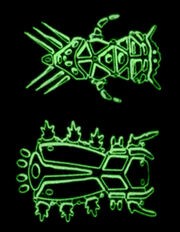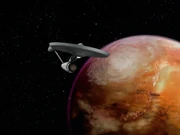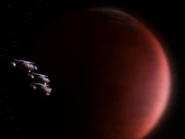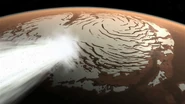(→Star Trek: Star Charts: rm off-topic solar system info) |
|||
| Line 140: | Line 140: | ||
==== ''[[Star Trek: Star Charts]]'' ==== |
==== ''[[Star Trek: Star Charts]]'' ==== |
||
| − | Mars (Sol IV) was located in the [[Alpha Quadrant]]. This planet was a [[Class K planet]]. The official name of this planet was the United Martian Colonies, and the UMC was founded in 2103. Mars was a charter member of the [[United Federation of Planets]] in [[2161]]. The capital was Utopia Planitia. The dominant species were Humans. In [[2378]], there were 133.8 million Humans living on Mars. Major points of interest were {{w|Olympus Mons}}, {{w|Valles Marineris}}, and the Utopia Planitia fleet yards. The original flag of the UMC was based on a painting of a bullfighter on velvet. The first manned landing on Mars was by ''Aries I'' in [[2030]]. |
+ | Mars (or Sol IV) was located in the [[Alpha Quadrant]]. This planet was a [[Class K planet]]. The official name of this planet was the United Martian Colonies, and the UMC was founded in 2103. Mars was a charter member of the [[United Federation of Planets]] in [[2161]]. The capital was Utopia Planitia. The dominant species were Humans. In [[2378]], there were 133.8 million Humans living on Mars. Major points of interest were {{w|Olympus Mons}}, {{w|Valles Marineris}}, and the Utopia Planitia fleet yards. The original flag of the UMC was based on a painting of a bullfighter on velvet. The first manned landing on Mars was by ''Aries I'' in [[2030]]. |
| − | + | The specifications for Mars were: |
|
* '''Diameter''': 6,790 kilometers |
* '''Diameter''': 6,790 kilometers |
||
* '''Distance from Sun''': 227,940,000 kilometers |
* '''Distance from Sun''': 227,940,000 kilometers |
||
| Line 151: | Line 151: | ||
* '''Moons''': {{w|Phobos (moon)|Phobos}}, {{w|Deimos (moon)|Deimos}} |
* '''Moons''': {{w|Phobos (moon)|Phobos}}, {{w|Deimos (moon)|Deimos}} |
||
* '''Orbital Facilities''': Utopia Planitia Fleet Yards |
* '''Orbital Facilities''': Utopia Planitia Fleet Yards |
||
| + | |||
| + | The Sol system was located in Federation space, in the Alpha Quadrant. The primary, '''Sol''', was a [[Star Trek: Star Charts#Spectral class|Class G star]] with a magnitude of +5. In [[1972]], the space probe ''[[Pioneer 10]]'' was launched from this system. On April 20, [[2151]]. the {{EnterpriseNX|name}} launched from this system on her maiden voyage. This system was a destination on the Earth trade routes in the mid-[[22nd century]]. In the early [[2270s]], [[V'Ger]] visited this system. In the late [[24th century]], this system was a destination on the major space lanes in the late [[24th century]]. (Pgs. 32, 36, 38, 44-45, 56, 60, 62, "United Federation of Planets I") |
||
=== Apocrypha === |
=== Apocrypha === |
||
Revision as of 22:31, 13 September 2012
AT: "xx" Template:Disambiguate Mars (or Sol IV) was the fourth planet in the Sol planetary star system. This system was located in Sector 001 (Sol sector), a region of space in the Alpha Quadrant. It was a terrestrial planet about half of that of Earth's radius with a thin atmosphere. The reddish-orange color of the Martian surface was due to the presence of iron oxide, also known as hematite. This planet had at least two moons. (TOS: "The Cage", "The Changeling", VOY: "Lifesigns")
History

Fossil remains of Martian insects
Due to its similarity with Earth, scientists believed it might hold life as well. In the early years of space exploration, various theories and projects were made to justify this. Eventually, scientists from Earth discovered microscopic evidence of ancient life on Mars in 1996. Larger fossils were discovered later on. (TNG: "The Last Outpost", "Datalore")
In 1947, several members of the United States military thought Quark, Rom and Nog were from Mars. Jeff Carlson and Faith Garland wondered if they might be able to have their honeymoon there. (DS9: "Little Green Men")
The 1970s was the beginning of the Mars projects. These projects, both manned and unmanned, explored the planet Mars. (VOY: "11:59")
In 1997 the NASA rover Sojourner became the first craft to explore Mars; the location later became a Mars Heritage Site.
In 2032, a manned Earth mission to Mars, the Ares IV, took place under the command of Lieutenant John Kelly. (VOY: "One Small Step"; ENT: "Demons")
Having been completed in 2012, the Millennium Gate served as a model for the first colony on the red planet. It pioneered many new technologies and scientific principles like a coverage by highly-reflective solar panels and being constructed as a self-contained biosphere. (VOY: "Lifesigns", "The 37's", "11:59") By 2069, Utopia Planitia was colonized. (ENT: "Terra Nova") The Martian colonies were established in 2103. Mars was visited by the Redjac entity who killed eight women of the Martian colonies. (TOS: "Wolf in the Fold")
As of the mid-2150s Humans installed a verteron array to redirect comets toward the polar caps for the purpose of terraforming. In 2155, Terra Prime - under the command of John Frederick Paxton - moved the Orpheus Mining Colony from Luna to Mars and hijacked the device in order to attack Starfleet Headquarters. Thanks to the efforts of Commander Charles Tucker III, the array fired harmlessly into the San Francisco Bay. (ENT: "Terra Prime")
In 2254, Mars was seen on a map depicting the inner Sol system. This map was scanned by the Talosians. (TOS: "The Cage")
Mars was featured in a nonsense-two-line poem that Charlie Evans forced Spock to recite in 2266: "Saturn rings around my head, down a road that's Martian red. (TOS: "Charlie X")
In 2267, Mars was seen on a chart depicting the Sol system. This map was scanned by Nomad. (TOS: "The Changeling")
In 2269, James T. Kirk argued in favor of having Sargon and his companions take over the bodies of the crew, and emphasized the benefits that it might possibly have on mankind, he explained, "they used to say if man could fly, he'd have wings. But he did fly. He discovered he had to. Do you wish that the first Apollo mission hadn't reached the moon or that we hadn't gone on to Mars or the nearest star?" (TOS: "Return to Tomorrow")
In 2274, Mars served as the launch point for the colony ship SS Artemis. (TNG: "The Ensigns of Command").
In 2372, Captain Benjamin Sisko and Constable Odo planned for Joseph Sisko and Jake Sisko to take a transport to Mars to avoid being caught in Admiral Leyton's coup d'état. (DS9: "Paradise Lost")
In 2376, Lieutenant Tom Paris mentioned that one of his ancestors flew the first orbital glider over the lower Martian plateau. (VOY: " 11:59")
The Kyrians in 3074 believed that Mars was the home of the USS Voyager, and not Earth as was the truth. A backup version of The Doctor corrected this error. (VOY: "Living Witness")
Political
As the first Human colony on Mars was established in 2103, the Fundamental Declarations of the Martian colonies were an important step in the pursuit of individual rights. Among the first colonists were relatives of Jean-Luc Picard (VOY: "The 37's"; TOS: "Court Martial"; Star Trek Generations). Utopia Planitia was established along with the Utopia Planitia Fleet Yards in geosynchronous orbit above, where many famous vessels including the USS Enterprise-D, the USS Voyager, and the USS Defiant were built. Mars was also an important part in the defense of the Sol system and the location of the Mars Defense Perimeter. (TOS: "Court Martial"; TNG: "The Best of Both Worlds"; Star Trek: The Next Generation Technical Manual)
Terraforming
Mars was the first planet to be terraformed by Humans. Colonists originally dwelt within domed cities while the verteron array was used to redirect comets and asteroids towards the Red Planet to impact in the polar caps. This freed carbon dioxide and released it into the atmosphere, increasing the planet's temperature and water volume. By 2155, conditions in the lowlands of the Martian surface were sufficiently altered to allow Humans to roam freely without heavy environmental suits (though one would still have to dress warmly for the near-arctic surface temperatures). (ENT: "Demons")
Literature
Mars was often featured in science fiction stories of the 20th century. In 1953, Benny Russell met a vendor in Harlem who found "men from Mars" to be unrealistic. After Douglas Pabst told Russell an African-American in charge of a space station was "not believable", Herbert Rossoff angrily retorted "and men from Mars are?" (DS9: "Far Beyond the Stars")
Other uses
A product known as "Mars Toothpaste", based on the name of the Roman god, was manufactured on the fourth planet of the 892 system in 2268. (TOS: "Bread and Circuses")
Alternate timelines
In an alternate timeline, Mars was wiped out by the Xindi following their destruction of Earth in 2154. (ENT: "Twilight")
Mars of 2371 was affected by the death of Gabriel Bell in 2024. (DS9: "Past Tense, Part I")
People
Locations
- Carl Sagan Memorial Station
- Martian colonies
- Martian Colony 3
- Utopia colony
- Starfleet Technical Services Academy
- Utopia Planitia
- Utopia Planitia Fleet Yards
Related topics
- Ares IV
- Fundamental Declarations of the Martian colonies
- Mars Defense Perimeter
- Orbital glider
- Starfleet Technical Services Academy
- Verteron array
Template:SolSystem
Appendices
Appearances and References
- TOS:
- TNG:
- VOY:
- "The 37's"
- "Future's End"
- "Lifesigns"
- "11:59"
- "One Small Step"
- "The Voyager Conspiracy" (on astrometrics screen)
- ENT:
- "Terra Nova"
- "Carbon Creek"
- "Demons"
- "Terra Prime"
Background
Behind the scenes
An illusory version of Mars was originally to have featured in TOS: "The Cage", with "an almost fairybook vine-covered cottage on one of the rural can-farms of Mars." The story outline for "The Cage" includes not only that description but also makes mention of frequent Martian "hay rides," such as Barth races that the Colonists Grange Society is planning, as well as "a fifty-mile sled ride down the Great Slopes" on the evening after the Barth races. (The Making of Star Trek, pp. 57-58)

The Enterprise flying by a planet which bears striking resemblance to Mars during the TOS-opening credits of the remastered versions
The remastered versions of Star Trek: The Original Series show the prominent red planet familiar from the original opening sequence to bear striking resemblance to Mars. Indeed, the producers used real photographs of Mars as textures for this computer-generated shot, showing a large canyon, which was in fact one of the most famous landmarks on Mars: "Valles Marineris", the deepest and longest canyon in the entire Sol system. Furthermore, the large cloud formation lies directly over the "Tharsis plateau", which is a region of increased cloud formation on Mars, too. If the producers really intended the planet to be Mars remains unknown so far. However, the color of its atmosphere glows pink near the day-night boundary, which would contradict this theory, as the Martian atmosphere appears blue during sunrise and sunset. On the other hand, this change of color could be a byproduct of terraforming.
In TNG: "The Best of Both Worlds, Part II", Mars was shown without any visible surface features besides the poles. Whether intentional or not, this is very similar to the planet's appearance during a global dust storm.
"The Explored Galaxy"
This chart was first seen, chronologically, in 2293. (Star Trek VI: The Undiscovered Country) This chart was also seen in several Star Trek: The Next Generation and Star Trek: Deep Space Nine episodes set in the 24th century, from the year 2364 to 2370. These were: TNG: "Conspiracy", "The Measure Of A Man", "The Emissary", "The Mind's Eye", "The Game" and DS9: "In the Hands of the Prophets", "Cardassians".
Star Trek: Star Charts
Mars (or Sol IV) was located in the Alpha Quadrant. This planet was a Class K planet. The official name of this planet was the United Martian Colonies, and the UMC was founded in 2103. Mars was a charter member of the United Federation of Planets in 2161. The capital was Utopia Planitia. The dominant species were Humans. In 2378, there were 133.8 million Humans living on Mars. Major points of interest were Olympus Mons, Valles Marineris, and the Utopia Planitia fleet yards. The original flag of the UMC was based on a painting of a bullfighter on velvet. The first manned landing on Mars was by Aries I in 2030.
The specifications for Mars were:
- Diameter: 6,790 kilometers
- Distance from Sun: 227,940,000 kilometers
- Surface Temperature: -120 °C to 25 °C
- Rotation Period: 24 hours 37 minutes
- Orbital Period: 686.9 days
- Gravity: 0.38 standard
- Moons: Phobos, Deimos
- Orbital Facilities: Utopia Planitia Fleet Yards
The Sol system was located in Federation space, in the Alpha Quadrant. The primary, Sol, was a Class G star with a magnitude of +5. In 1972, the space probe Pioneer 10 was launched from this system. On April 20, 2151. the Enterprise launched from this system on her maiden voyage. This system was a destination on the Earth trade routes in the mid-22nd century. In the early 2270s, V'Ger visited this system. In the late 24th century, this system was a destination on the major space lanes in the late 24th century. (Pgs. 32, 36, 38, 44-45, 56, 60, 62, "United Federation of Planets I")
Apocrypha
In the Star Trek: SCE novel Aftermath, Boothby was identified as a Mars native, an homage to Ray Walston's role as the title character in My Favorite Martian.



